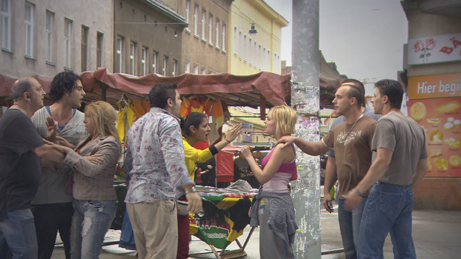Canadian-born artist Mark Lewis is known for short films that conceptually and formally explore how moving images are made and understood. Though Lewis trained and began working as a photographer, in the mid-1990s he started experimenting with film and since then has completed dozens. Like a number of fellow Canadian picture makers—among them photographer Jeff Wall—he is interested in how moving images are put together and function. One of his earliest films, _The Impossible Films_ (1995), highlights the myriad ways in which cinematic tropes convey information. The twenty-eight-minute film consists of two consecutive shorts, both of which feature extensive opening credits, music, and bits of action and dialogue in various locations but no dramatic narrative arc. The film demonstrates how heavily movies rely upon context to tell a story. _The Pitch_ (1998) calls attention to another important filmic element that often goes unnoticed: the extra. The four-minute-long film is a single-take of Lewis delivering a monologue. In it he describes extras as the necessary, invisible, exploited laborers of cinema and ends with a pitch for a film featuring only them. As the camera pulls back and reveals a set filled with milling people, we realize that Lewis has been proposing the kind of meta-film we have just seen.
A number of Lewis’s works examine camera techniques and their effects. For example, several of the films he showed in the Canadian pavilion at the 2009 _Venice Biennale_ explored rear projection, a technique in which actors stand in front of a screen onto which background footage originally shot outside is projected. In the pavilion Lewis presented _Backstory_ (2009), a documentary that addresses the history of the technique, which was developed in the late 1920s so that filmmakers could mitigate ambient sound and efficiently use exotic locales. He also showed his short film _Nathan Phillips Square, A Winter’s Night, Skating_ (2009), which looks as if it were shot entirely at an outdoor ice rink, when in fact it was completed inside a theater.
Another style of camerawork that Lewis has considered is the long take, which was used by filmmakers such as Andy Warhol and Michael Snow in the 1960s to make long shots of barely moving subjects. While Lewis has used this technique to make works in which little seems to occur, in his recent film _The Fight_ (2008) he uses it to represent and generate tension. This six-minute piece is a single take of six men and three women brawling at an outdoor street market. Because the film is silent, the actors’ aggressive physical gestures become the central focus. Just as one person is held back and calmed down, another’s anger flares up and the fighting escalates. Because the video is shown on a loop, there is no end to the drama. The tension builds, recedes, and builds again. In this film, as in many of Lewis’s, that which is often in the background is thrust forward; the incidentals shift from supporting characters to the main attraction. _—Kate Green_

